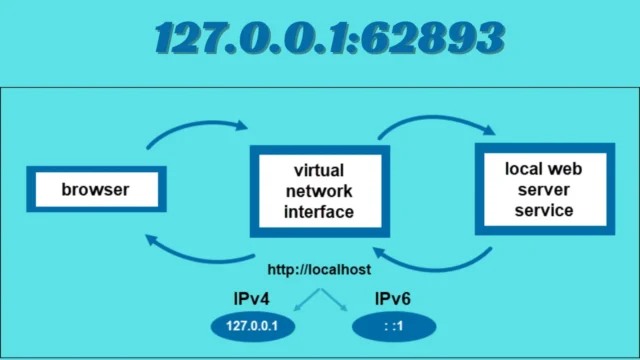Errors can be really annoying, especially when you don’t know why they happen. Imagine you’re using your computer and suddenly see an error message like “127.0.0.1:62893”. It can really slow you down as you try to figure out how to fix it. But to fix any error properly, you need to know what’s causing it.
If you’re dealing with this problem and need a fix, you’re in the right place. This post will explain the issue, why it might be happening, and how to solve it.
What Is 127.0.0.1:62893 Error?
The error code “127.0.0.1:62893” has two parts: “127.0.0.1” and “62893”. Let’s break them down and look at each part individually:
127.0.0.1
This special IP address, “127.0.0.1”, serves as a loopback path, meaning it allows a computer to refer to itself. You can think of it as the computer’s own local host.
62893
This port number, “62893”, is important for transferring data between various applications. But it’s not a standard port and isn’t commonly used by caching systems such as Memcached.
Is Code 127.0.0.1:62893 Not Good?
No, the code “127.0.0.1:62893” isn’t harmful to your computer and actually has various uses:
- Security: Port activities help detect suspicious computer behavior, like trying to access information without permission, which is crucial for maintaining security.
- Development and Testing: “Localhost” (referring to “127.0.0.1”) is useful for developing and testing applications. Many developers use it as a safe, offline environment for testing.
- Creates A Separate Space: It provides developers with a dedicated area for testing and development, so they can work without interfering with other applications.
- Debugging And Networking: Localhost helps users identify network problems early on, allowing for quicker troubleshooting and debugging.
Process Of 127.0.0.1:62893
Here’s how the localhost code “127.0.0.1:62893” works:
- When an application on your computer needs to talk to another process running on the same machine, it sends a message to “127.0.0.1” (which is the localhost) indicating that it wants to communicate with another process.
- The localhost then forwards this message to port number “62893”, instructing the computer to direct the communication to a specific service or process.
Consequences Of Exposing Port 62893 Publicly
Exposing port 62893 publicly isn’t safe, and here’s why:
- Unverified Users: Making port 62893 accessible to the public is risky for your computer’s security. Unverified users might try to access your Memcached server and exploit it for malicious purposes.
- Compromised Security: Security is crucial in today’s digital age. Exposing port 62893 could make your Memcached vulnerable, allowing attackers to gain unauthorized access to it and potentially cause harm.
How To Resolve “Disconnected From The Target VM, Address: 127.0.0.1:62893” Error?
Are you encountering the error message “Disconnected From The Target VM, Address: 127.0.0.1:62893” while using development tools? If so, here are some steps to help you resolve this issue:
Review The Application
First, check the application settings to ensure everything is configured correctly from your end.
Match Port Number
The next step is to ensure that the port number matches – it should be set to 62893. If it’s different, you’ll need to apply different configurations and
Resolving The Issue
To resolve the issue, follow these steps:
- Double-check the command you’re using to ensure it’s correct.
- If there’s a port conflict, try changing to a different port number. Adjust the application’s settings accordingly.
- For Windows users, ensure your firewall settings allow access. Open the Control Panel, navigate to Windows Defender Firewall settings, select Advanced Settings, and create a custom inbound rule to exempt port 62893.
- Mac or Linux users can adjust firewall settings using terminal commands.
- Review the application’s documentation to ensure it’s configured correctly.
- Check if any other application is using port 62893 and causing conflicts. Use network diagnostic tools for precise identification and resolution.
Important Points
If you’re still encountering the same issue despite following the previous steps diligently, consider these options:
- Contact the Application Developer: Don’t hesitate to reach out to the developer of the application. You can easily find their contact information via email or social media platforms. They may provide further guidance or assistance.
- Reset Everything: This should be your last resort. Resetting everything will restore settings to their default state, potentially resolving the issue. However, be sure to back up all your data beforehand.
Conclusion
Machines are fascinating tools that allow us to accomplish many tasks efficiently. However, errors can sometimes cause problems for users. Having a clear understanding of how machines work can help you quickly solve these issues. In this post, we’ve discussed details related to “127.0.0.1:62893”. We hope you found it informative and useful. If you did, feel free to share it with others to help them understand it better too.











